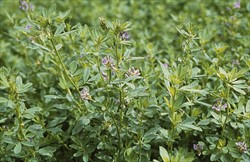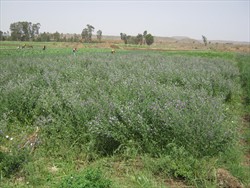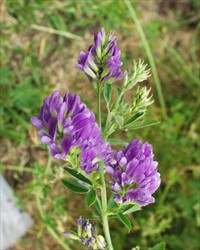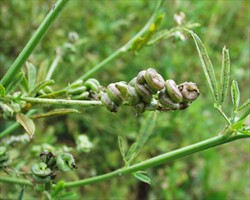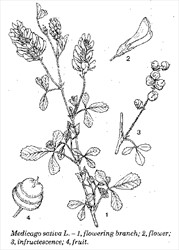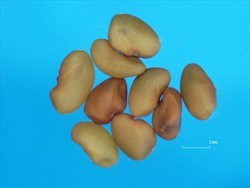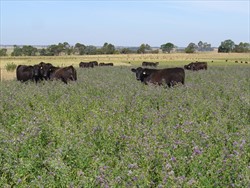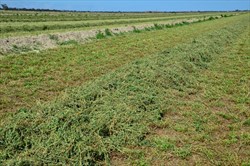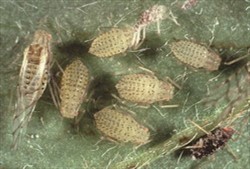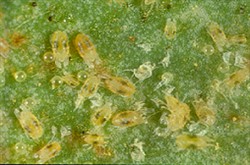Medicago sativa
Tropical Forages
Medicago sativa L.
Subordinate taxa
Medicago sativa L. nothosubsp. tunetana Murb.
Medicago sativa L. nothosubsp. varia (Martyn) Arcang.
Medicago sativa L. subsp. caerulea (Less. ex Ledeb.) Schmalh.
Medicago sativa L. subsp. falcata (L.) Arcang.
Medicago sativa L. subsp. glomerata (Balb.) Rouy
Medicago sativa L. subsp. sativa (the form most commonly used in agriculture)
Medicago sativa L. subsp. falcata (L.) Arcang. var. falcata (L.) Döll
Medicago sativa L. subsp. falcata (L.) Arcang. var. viscosa (Rchb.) Posp.
Medicago sativa: Medicago caerulea var. pauciflora (Ledeb.) Grossh.; Medicago karatschaica Latsch.; Medicago lavrenkoi Vassilcz.; Medicago pauciflora Ledeb.; Medicago sativa var. pilifera Urb.
nothosubsp. tunetana: Medicago grossheimii Vassilcz.; Medicago polychroa Grossh.; Medicago sativa f. gaetula Urb.; Medicago sativa subsp. faurei Maire; Medicago tunetana (Murb.) Vassilcz.
nothosubsp. varia: Basionym: Medicago × varia Martyn; Medicago falcata var. ambigua Trautv.; Medicago glutinosa subsp. praefalcata Sinskaya; Medicago hemicycla Grossh.; Medicago komarovii Vassilcz.; Medicago media Pers.; Medicago sativa nothosubsp. hemicycla (Grossh.) C.R. Gunn; Medicago sativa subsp. ambigua (Trautv.) Tutin; Medicago sativa subsp. praefalcata (Sinskaya) C.R. Gunn; Medicago sativa var. varia (Martyn) Urb.; Medicago schischkinii Sumnev.; Medicago tianschanica Vassilcz.; Medicago trautvetteri Sumnev.; Medicago vardanis Vassilcz.
subsp. caerulea: Basionym: Medicago caerulea Less. ex Ledeb.; Medicago hemicoerulea Sinskaya; Medicago sativa subsp. microcarpa Urb.
subsp. falcata: Basionym: Medicago falcata L.; Medicago borealis Grossh.; Medicago difalcata Sinskaya; Medicago falcata var. romanica (Prodán) O. Schwarz & Klink.; Medicago quasifalcata Sinskaya; Medicago romanica Prodán; Medicago tenderiensis Opperman ex Klok
subsp. falcata var. viscosa: Basionym: Medicago procumbens var. viscosa Rchb.; Medicago falcata subsp. glandulosa (W.D.J. Koch) Greuter & Burdet; Medicago falcata var. glandulosa W.D.J. Koch; Medicago glandulosa Davidov; Medicago sativa f. viscosa (Rchb.) Urb.; Medicago sativa subsp. viscosa (Rchb.) C.R. Gunn
subsp. glomerata: Basionym: Medicago glomerata Balb.; Medicago glutinosa M. Bieb.; Medicago gunibica Vassilcz.; Medicago sativa f. glutinosa (M. Bieb.) Urb.
subsp. sativa: Medicago agropyretorum Vassilcz.; Medicago asiatica Sinskaya; Medicago mesopotamica Vassilcz.; Medicago praesativa Sinskaya; Medicago rivularis Vassilcz.; Medicago sogdiana Vassilcz.; Medicago transoxana Vassilcz.
Family: Fabaceae (alt. Leguminosae) subfamily: Faboideae tribe: Trifolieae.
There is considerable variation among the various subspecies of Medicago sativa, but since subsp. sativa is the main form used in warmer environments, the description below relates to that subspecies only.
Herbaceous perennial with deeply penetrating taproot. Stems procumbent, ascending to erect, arising from a woody base, 30–80 (–120) cm long. Leaf trifoliolate; stipules triangular, 5–15 mm long; pubescent on lower surface, glabrous on upper surface, coarsely toothed; petiole pubescent, 5–30 mm long, leaflets narrow, oblong to ovate or obovate, 8–28 mm × 3–15 mm, dentate near apex, glabrous on upper surface, slightly pubescent on lower surface. Inflorescences in dense racemes with 10–35 flowers, on peduncles 1–5 cm long; pedicel 1.5–2 mm long; calyx 5-lobed, 3–6 mm long, tube and pointed teeth about equal in length; corolla purple or blue, rarely white. Pod curled, 3–10 mm in diameter, indehiscent, not spined, containing 2–6 seeds. Seeds yellow to brown, kidney-shaped to ovoid, 1–2.5 mm × 1–1.5 mm. 240,000–500,000 seeds per kg
Africa: lusern (Afrikaans)
Asia: barsym, barysm haijazi, burseem, jatt (Arabic); 紫苜蓿 zi mu xu (China); aspeset, aspeset tarbutit (Hebrew); murasaki-umagoyashi (Japan); jajukgaejari (Korea); adi yonca (Turkish)
English: lucerne, violet-flower lucerne, bastard medic, sand lucerne, variegated lucerne; alfalfa (USA); purple clover (China); lucerne grass, sickle medick, yellow medick (India)
Europe: luserni, mailanen, sinimailanen (Finnish); luzerne bigarrée, luzerne cultivée, luzerne intermédiaire (French); Bastardluzerne, blaue Luzerne, echte Luzerne, Sandluzerne (German); Μηδική, midkí i ímeros (Greek); lucerna (Hungarian); erba medica, medica (Italy); nefel (Maltese); alfalfa, luzerna (Portuguese); alfalfa de las arenas, alfalfa híbrida, alfalfa rústica, mielga (Spanish); blålusern (Swedish)
Indian subcontinent: hol, kudiraimasal, lasunghas, wilayati-gawuth, lusan, vilayati-hullu, vilayati-gavat, vilayati ghas: વિલાયતી ઘાસ vilayati ghas (Gujarati); लुसन घास lusan ghas (Hindi); ಲುಸರ್ನೆ ಸೊಪ್ಪು lusarne soppu, ವಿಲಾಯಿತಿ ಹುಲ್ಲು vilaayiti hullu (Kannada); विलायती गवत vilayati gavat (Marathi); ਦੁਰੇਸ਼ਤਾ dureshta, ਸਿੰਝੀ sinjhi (Oriya); अश्वाबला ashvabala (Sanskrit); குதிரை மசால் kutirai macal (Tamil); lasan (Urdu)
Native:
Africa: Algeria, Libya, Morocco, Tunisia
Asia: Afghanistan; Armenia; Azerbaijan; China (n.); Cyprus; Georgia; Iran; Iraq; Israel (rare); Jordan; Kazakhstan; Korea; Kyrgyzstan; Lebanon; Mongolia; Pakistan; Russian Federation (Eastern & Western Siberia, Far East); Syria; Tajikistan; Turkey; Turkmenistan; Uzbekistan
Europe: Albania; Austria; Belarus; Belgium; Bulgaria; Czechoslovakia; Denmark; Estonia; Former Yugoslavia; France; Germany; Greece; Hungary; Ireland; Italy; Latvia; Lithuania; Moldova; Netherlands; Norway; Poland; Portugal; Romania; Russian Federation (European part); Spain; Sweden; Switzerland; Ukraine (incl. Krym); United Kingdom
Note: within this range, the most commonly cultivated subsp. sativa is native to Afghanistan, Iran, Iraq, Turkey.
Naturalized:
Africa: Azores; Egypt; South Africa
Asia: India; Nepal; Sri Lanka
Australasia: Australia; New Zealand
Europe: Finland
Northern America: Mexico; USA
South America: Argentina; Brazil (s.); Chile; Ecuador; Peru; Uruguay (s.)
Cultivated:
Temperate, Mediterranean, subtropical and upland tropical regions across the world.
Forage
M. sativa was one of the first forage crops to be domesticated. It is used as multi-purpose high protein forage in both grazing and conservation (hay, silage, meal and forage dehydration) systems. It can be sown as a pure stand or in mixtures with both temperate and tropical grasses.
Environment
It is often used in as a pasture ley in cropping land to improve the soil nitrogen status.
Other
It has a role in traditional medicines, and the seed can be sprouted for human consumption.
Soil requirements
In the wild, M. sativa tends to occur on sandy and sandy-loam soil types in coastal areas and on clay and heavier clay-loam soil types in mountainous regions. In cultivation, it demands deep, well-drained soils with a neutral to slightly alkaline pH. It will grow in sands to moderately heavy clays, provided drainage is satisfactory.
Moisture
It is a crop that is relatively drought tolerant and will produce yields about in proportion to the water supply. In periods of drought, it will adjust plant density to cope with the availability of water supply. Its taproot is capable of following water supply to considerable depths (up to 8 m, but more commonly 2‒3 m). It is well suited to growing under irrigation. It is intolerant of even short periods of flooding or waterlogging.
Temperature
Optimum temperatures for dry matter production appear to be in the range 15‒25 ºC in the day and 10‒20 ºC during the night. However this may differ with the winter activity level of the cultivar (how quickly it can grow during the cool season). Again there is variation in the way lucerne cultivars react to cold. The foliage of winter active cultivars can be damaged by frost and killed by snow while winter dormant cultivars avoid damage by remaining dormant during freezing conditions.
Light
Lucerne needs high light intensity for maximum growth but its erect growth habit allows it to compete well for light when sown in mixtures. Young seedlings are intolerant of shading as a result of competition from broadleaved weeds. Hence defoliation is an oft-used method of correcting weed problems in establishing pure stands or grass competition in mixed stands.
Reproductive development
In the subtropics lucerne plants flower throughout the year. Winter dormant cultivars have a high proportion of plants that have a long-day flowering requirement but winter active cultivars have a greater proportion of day neutral plants. The length of time to first flower appearance varies with season as the plant's response to day length is influenced by temperature. Flowers are largely insect pollinated, commonly by Apis mellifera, but also by insects outside the order Hymenoptera.
Defoliation
Defoliation timing is most appropriately matched to the build up of carbohydrate reserves in the plant's roots. Levels in the roots are lowest about 2 weeks after cutting and reach a maximum at full bloom. This varies with the winter activity of the cultivar and with time of the year. The timing of defoliation for a semi winter-dormant cultivar such as the older Australian cultivar, 'Hunter River', was determined when 10% of the stems on individual plants were flowering. Highly winter-active cultivars do not flower as actively and timing is best done when the basal shoots are around 5 cm in length. M. sativa is intolerant of continuous grazing and should be rotationally grazed for long-term persistence, whether grown as a pure stand or in mixed swards. Even under extensive grazing, where rotational grazing can not be easily employed, lucerne should be given at least one, and preferably more, stock-free periods a year. Management practices designed to extend the life of grazed lucerne/alfalfa stands include: low stocking rates, ensuring that the stand is well established before grazing, sowing palatable species with lucerne so that lucerne is not preferentially grazed and using disease-resistant dormant and semi-dormant cultivars with low crowns.
Fire
M. sativa is tolerant of the "cool" fire used to remove compacted and moist spoiled windrowed hay in recently defoliated stands. Hot fires in upright stand and where the material is relatively dry may be more damaging.
Note
The various forms of the species occupy a range of different habitats, providing plant breeders with genetic traits influencing adaptation to particular environmental factors that might improve commercial varieties.
Subsp. sativa is rare in the wild, but is generally found on moderately fertile calcareous soils, commonly in open habitats, less frequently in scrub and woodland, in semi-arid to sub-humid environments.
Subsp. caerulea occurs in semi-deserts, often exhibiting tolerance to drought and soil salinity.
Subsp. glomerata grows in calcareous soils in montane areas (sub-alpine meadows, scrub, forest glades and river valleys) with at least 500 mm of precipitation.
Subsp. falcata var. falcata occupies a very diverse range of habitats across much of northern Europe and Asia, particularly under dry steppe conditions.
Subsp. falcata var. viscosa is largely associated with lower areas of montane regions.
Guidelines for establishment and management of sown forages.
Establishment
Under the grazing or cutting schedules used in the subtropics, lucerne rarely sets seed so the initial population achieved at establishment strongly influences the long-term performance of the stand. Lucerne should be established in a fine, firm, weed-free seedbed. Sowing rate depends on what the stand will be used for; pure swards under irrigation should be sown at 12‒15 kg/ha, dryland pure swards at 4‒8 kg/ha and mixed swards for grazing at 1‒3 kg/ha. Lucerne will establish throughout the year in the subtropics and upland tropics, but autumn and early winter are best as weed competition is lowest at these times. Weed control (strategic mowing or grazing, pre- and post-establishment herbicide application) is essential during the establishment phase in pure swards used for hay production. For grazed swards, strategic slashing or mowing will control most weed problems.
Fertilizer
Lucerne needs medium to high fertility soils with a neutral to moderately alkaline pH for optimum production. Potassium, phosphorus and sulphur levels need to be maintained at the following levels: K, 0.3 meq/100 g; P, 25 mg/kg; and S, 10 mg/kg. The plant's nodules should satisfy nitrogen requirements if inoculation is effective. Responses to nitrogen fertilizer can occur in winter but the economics are questionable. On marginal fertility soils, responses to magnesium, manganese, zinc, molybdenum, boron and copper can occur. Test strips of the respective nutrient should be applied to determine if soils are deficient. Aluminium toxicity can occur on soils with pH of lower than 5.5.
Compatibility (with other species)
Lucerne is compatible with tropical grasses under rain grown conditions, especially in drier environments (<600 mm). In higher rainfall areas, disease and grass competition limit its life span to 1‒2 years. Lucerne is compatible with temperate grasses, especially prairie grass (Bromus spp.), under irrigation. Management should aim to reduce competition from the companion grass to improve lucerne stand longevity.
Companion species
Grasses: Bromus spp. (cooler upland environments), Cenchrus ciliaris, Chloris gayana, Megathyrsus maximus, Panicum coloratum, Setaria incrassata
Legumes: Clitoria ternatea, Macroptilium atropurpureum, M. bracteatum, M. lathyroides
Pests and diseases
Lucerne is susceptible to an extremely large range of pests and diseases in warm climates. Phytophthora root rot, anthracnose and other crown rots, rhizoctonia and the leaf diseases (stemphylium and pepper spot) are the most serious diseases. Spotted and blue green aphids, jassids and leaf roller are the most damaging pests. Considerable breeding effort has gone into improving the pest and disease resistance of current lucerne cultivars. However it needs to be realised that, at best, these cultivars are tolerant, rather than resistant. Severe infestations or infections will still result in substantial damage.
Ability to spread
Lucerne has little ability to spread in warmer environments because it rarely sets seed under the management conditions imposed.
Weed potential
Lucerne has a very low rating as a potential weed. It sets little seed, is not highly competitive with even moderately aggressive grasses and is highly susceptible to most herbicides that are active against broadleaved species.
Nutritive value
It is usually considered the 'King of Fodders' because it produces high quality feed throughout the year if soil moisture is available. Protein and calcium levels are high, relative to other fodders, but metabolizable energy (ME) and phosphorus levels are low. ME and phosphorus levels are good in young growth but drop rapidly as the foliage matures. Intake of digestible nutrients by livestock is higher than for most other forages. Level of fibrous tissue is low and this allows rapid passage through the rumen.
Palatability/acceptability
Lucerne is highly palatable. There are some cultivar differences in palatability and this is thought to be the result of different protein fractionations.
Toxicity
Bloat is the major limitation to grazing lucerne. A combination of management and control measures can be used to reduce the risk of animals bloating on lucerne. Hungry animals are more at risk of bloat and should be provided with access to a source of roughage before or during grazing. There is usually reduced risk of bloat in mixed stands under rain grown conditions. Access to anti-bloating agents (drenching, in their water supply, rumen capsules or sprayed on foliage) is essential in intensively grazed situations. Wethers can get more pizzle rot on lucerne than if grazing grass pastures. Enterotoxaemia can also be a problem with sheep. Both can be controlled by injections.
Feedipedia link
Dry matter
Under irrigation, lucerne is capable of producing 25‒27 t/ha dry matter in the first year of a stand and this can fall to as little as 8‒15 t/ha by the third year. Production can be related to plant density, level of disease and pest resistance and winter activity level of the cultivar. Under rain-grown situations it is also determined by availability of soil moisture. Good irrigated stands can produce 20 t/ha of hay per year (allowing for at least one spoiled cut per year). A utilisation figure of 50% is expected under grazed conditions.
Animal production
When green feed is available, daily liveweight gains for beef cattle will be around 0.7 kg/head/day compared with 1 kg/head/day on oats, improved tropical pasture and native pasture. This reduced weight gain is a result of the lower energy availability. However lucerne grows throughout the year so, over the full year, supplementing native pasture with lucerne can increase gains from 0.5 to 0.7 kg/head/day at double the stocking rate. Irrigated lucerne can carry a beef cow and a calf on 0.5 to 1 ha on a year-round basis. Supplementing dairy cows grazing tropical grasses with lucerne can raise milk production from 10‒12 to 14‒15 L/cow/day. This can increase to 20 L/cow/day if the cows are further supplemented with grain to combat the energy deficiency. Sheep numbers can be increased from 6 to 15/ha by supplementing native pasture with lucerne. Irrigated lucerne can carry more than 80 dry sheep equivalents/ha from October to May.
2n = 16, 32, 64. Lucerne is a naturally outcrossing plant that requires bees for pollination. It can self-pollinate, although outcrossing is the more likely mode of breeding. Inheritance within lucerne is a complex process as the plant is an autotetraploid, which produces a diploid gamete. Lucerne is very sensitive to even a small level of inbreeding, which results in substantial depression in yield.
There has been an enormous amount of effort conducted into plant breeding on lucerne around the world through both Government and commercial breeding organisations. Most of the work has gone into selecting lucerne cultivars with winter activity levels and disease and insect resistances of the various lucerne-growing regions. The number of lucerne cultivars registered around the world numbers in the hundreds.
Seed production is a specialised activity. Fertilizer management, irrigation, weed control and the availability of bees for pollination need to be controlled for optimum seed production. There are substantial differences between cultivars in potential seed production, which can affect market penetration of a cultivar. Seed yields of 180‒280 (‒400) kg/ha are achieved by specialist seed producers. Little seed is produced outside Mediterranean, continental and temperate areas.
Weeds reduce yield, quality and the useful life of pure lucerne stands, but are less of a problem in mixed swards. No one herbicide will control all weeds in lucerne so various herbicides are registered for specific actions in a lucerne crop. Choice depends on the type of weed, the purpose of the crop (seed production, livestock feed), and the state and stage of growth of the lucerne. There are also differences in the tolerance of some lucerne cultivars to herbicides. Herbicides can be used to selectively take out grasses or broadleaved weeds or to be used pre-planting or post planting to tackle weeds at different stages of the crop.
- Year-round production.
- High quality.
- Dual purpose (grazing or conservation).
- Ability to extract water from deep soil layers.
- Persistent.
- Wide range of climatic adaptation.
- Responsive to irrigation.
- Low energy levels.
- Restricted soil adaptation (fertile, well-drained).
- Does not tolerate continuous grazing.
- Causes bloat.
- Susceptible to waterlogging.
Anon. (2002) Lucerne Management Handbook (4th Edition). Department of Primary Industries, Brisbane, Australia.
Clements, R.J. (1992) Medicago sativa L. In: Mannetje, L.’t and Jones, R.M. (eds) Plant Resources of South-East Asia No. 4. Forages. Pudoc Scientific Publishers, Wageningen, the Netherlands. p. 161–163. edepot.wur.nl/327785
Frame, J., Charlton, J.F.L. and Laidlaw, A.S. (1998) Temperate forage legumes. CAB International, New York, USA.
Hanson C.H. (ed). (1972) Alfalfa science and technology. American Society of Agronomy, Madison, WI, USA.
Most countries with a history of cultivation of M. sativa have produced numerous cultivars to meet their specific needs. It is not feasible to list even currently available cultivars for each country in this database.
Plant improvement has focused on plant breeding rather than selection from wild types.
